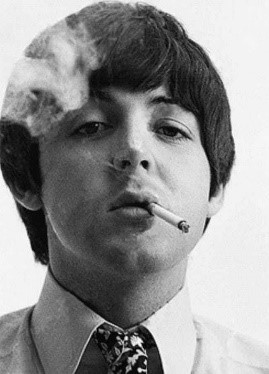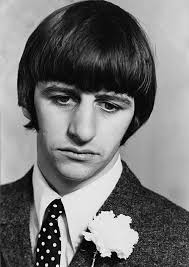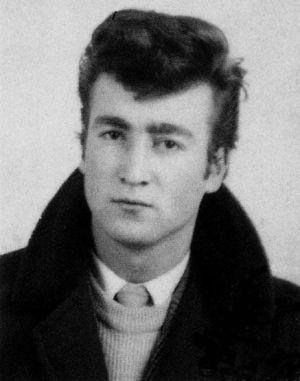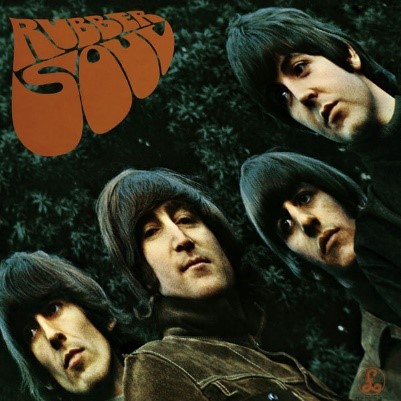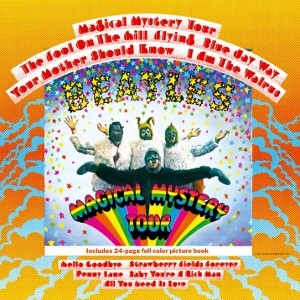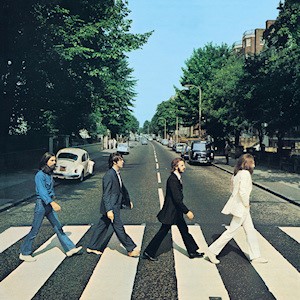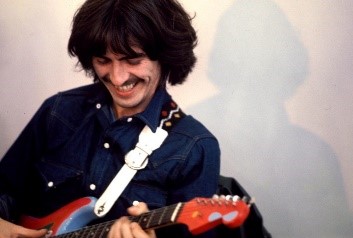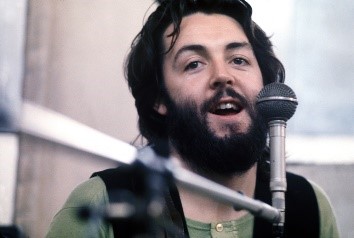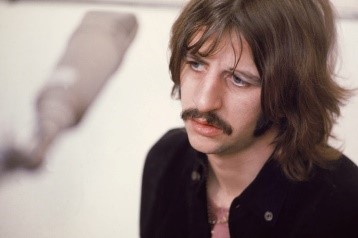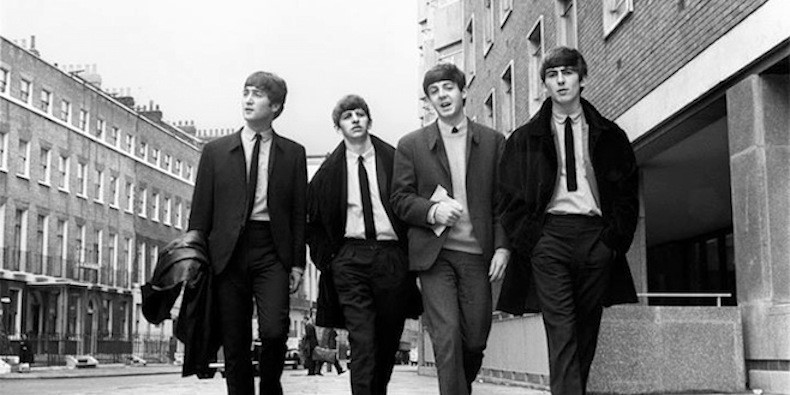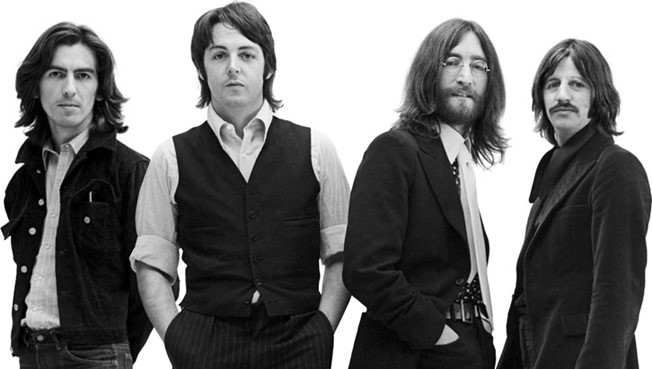Magical Mystery Tour: A Deep Dive Retrospective of The Beatles
Click below on the streaming service of your choice to listen to the playlist as your read along.
No matter your age or where you come from, it’s likely you know at least a few Beatles songs. Writing about such a fabled and chronicled band may seem daunting and superfluous, but since this bug to chronicle my musical tastes on Ceremony has taken hold, these major artists, the beloved of my collection, cannot be ignored. While my focus is generally on modern rock, you can’t understand how that arrived without checking out what came before.
The pictures of The Beatles included with the White Album, clockwise from top left: John Lennon, Paul McCartney, Ringo Starr, and George Harrison
When I explored The Rolling Stones’ deeper cuts it was to discover them and educate myself on what hadn’t found its way to me on its own. This is not the case with The Beatles. As often note, my older brother (by ten years) was a huge influence on my musical education and The Beatles were his favourite band. I grew up listening to them since I was a toddler and staring at their faces on the wall over my brother’s desk (the poster inserts from the White album); and while I eschewed many of the other artists of their era that my brother introduced me (until much later), I could not do so with the Fab Four. They are undeniable.
The Playlist
Misery
There's A Place
I'll Get You
Don't Bother Me
Hold Me Tight
I'm Happy Just to Dance with You
Things We Said Today
Baby's in Black
Every Little Thing
The Night Before
You're Gonna Lose that Girl
The Word
Wait
Rain
I'm Only Sleeping
And Your Bird Can Sing
Fixing A Hole
Within You Without You
Flying
Blue Jay Way
I Will
Everybody's Got Something to Hide Except for Me and My Monkey
Hey Bulldog
It's All Too Much
Old Brown Shoe
Oh! Darling
I Want You (She’s So Heavy)
Dig A Pony
I've Got a Feeling
The Beatles only existed for eleven years and released music over eight, yet the quality, consistency, and volume of their output over that span was stupendous. Their sonic evolution was remarkable and it’s hard to keep in mind it happened over such a short span. Through each phase of their development it’s startling to step back and realize each was only a year or two in duration. What is also surprising is how well their music holds up. It’s easy to think their influence and stature are a result of having existed during the earliest years of rock and pop’s evolution – to assume their success was by virtue of standing tall in a small and nascent field of new acts – but that would be a misguided view of their legacy. Instead the opposite is true, without the Beatles the genres of rock and pop music would have evolved more slowly and taken longer to become the varied and complex universe it has become, barely sixty years or so since its birth.
Since it’s easy to find The Beatles’ greatest hits – it’s hard to avoid them – as I like to do, I will bypass the tried and true and, knowing their albums well and having many favourites among their lesser known tunes, I am happy to use the deeper tracks to profile their incredible career.
Misery; There’s A Place \ Please Please Me (1964)
The sudden and rapid rise of The Beatles wasn’t so sudden or rapid when you consider their history prior to releasing their first single. John Lennon, Paul McCartney, George Harrison and Stuart Sutcliffe started playing together as teenagers in late 1950s Liverpool, evolving from skiffle acts to a rock band. Settling on the name The Beatles as a tribute to Buddy Holly and The Crickets, the band added Pete Best as drummer and in the fall of 1960 landed a residency amongst the strip clubs of Hamburg, Germany. Over the course of three years the band would play regularly during several residencies, playing several sets per day and through the night, perfecting their sound and act. During this time, the scene in Liverpool was catching up to the new rock sounds and the band started playing regularly at The Cavern Club. In 1961, Sutcliffe left the band and McCartney took over on bass. In 1962, they were taken up by manager Brian Epstein and with his persistence finally landed a contract with EMI Parlophone, signed by producer George Martin.
Soon into their first recordings at Abbey Road studios they made the decision to remove Best as drummer and replace him with Richard Starkey, who performed under the name Ringo Starr. Even still, they used session drummers to complete their initial recordings. It would be an unfortunate plight for Ringo to forever be perceived as the lesser band member compared to his luminary bandmates. Their first single, “Love Me Do,” released in October of 1962, gave notice this band was something special. The second single, “Please Please Me,” would deliver their first number one single. The band’s strong melodies, pitch perfect harmonies, and tight playing set them apart from other acts vying for attention amongst the changing pop genre.
The first album soon followed in the Spring of ’63 and included the prior singles and B-sides. An additional ten songs were recorded in a single marathon session at Abbey Road using full live takes. Please Please Me captured the energy and charisma of this band, polished from their three heavy years of playing to the varied audiences of Hamburg and Liverpool. Six songs were covers and the rest were from Lennon, McCartney, or joint compositions of the two as they established their legendary partnership. For most of the band’s career the two agreed to release all songs under the “Lennon-McCartney” identification regardless of which wrote the song. One song each, both covers, were sung by Harrison and Starr individually, as would become the custom on all their albums to ensure all contributed. In addition to the lead singles the album would be known for “I Saw Her Standing There,” “Do You Want to Know A Secret,” and their definitive cover of “Twist and Shout.”
What this playlist will establish quite strongly is that The Beatles wrote very few bad songs. Their success, especially early on, was a result of masterful melodies. “Misery” captured this well, along with the harmonies that were common of the early rock songs of the ‘60s. “There’s A Place” showed how tight the band performed, in which their simple and sparse playing still created a large sound, punctuated by a strong harmonica accent. It was the first album, but they were already polished and delivering high quality songs.
The Hamburg era Beatles: John Lennon, George Harrison, Pete Best, Paul McCartney, Stuart Sutcliffe
I’ll Get You \ B-Side to “She Loves You” (1963)
In the early ‘60s the single was the focus of the music industry. 7” singles and radio airplay drove all attention and success. The album was almost an afterthought and singles were issued separately to maximize their sales and not be watered down by being available on the album. Recall their first two singles were only added to the first album since they had already been issued prior.
After the release of Please Please Me the band issued two singles, “From Me to You” and “She Loves You,” both of which would shoot to number one. “I’ll Get You” was the B-side to “She Loves You” and offered up a slightly different and more nuanced tempo than the bouncy, pop sounds of the singles, especially it’s A-side.
Don’t Bother Me; Hold Me Tight \ With the Beatles (1963)
The band put out their second album later the same year, releasing it in the fall. It would displace their first album in the number one slot on the charts, where it had resided for the previous thirty weeks. All of their albums, save for one, would reach #1 in the UK. The quick release of a follow-up was normal for bands in that era, but the quality of this was indicative of the pent up output this band had and the presence of three strong songwriters in their fold. The album still had five covers on it including “You Really Got A Hold On Me,” “Please Mister Postman,” “Roll Over Beethoven,” and “Money (That’s What I Want)” – for all of which The Beatles versions are definitive.
Given the short time between the albums, the sound of this album was consistent with the first. Yet the harmonies on “Don’t Bother Me” seemed a little deeper and cleaner, the instrumentation a little tougher, and the drumming a bit jazzier on the fills. Already the band was progressing their sound. “Hold Me Tight” was a masterpiece of their early sound, with fantastic marching guitars that drew a little bit of a surf sound and included a catchy, clapping accompaniment that showed their studio work was starting to build out from their live sound.
Their increasing dominance of the charts was catching the attention of the general media and a growing population of young fans. After several tours of England and then a short jaunt through Sweden, their first outside of England other than Germany, the band started to find their arrivals back home and at shows greeted by groups of increasingly unruly, screaming fans and a phalanx of journalists to document the occasion. Beatlemania was born.
Epstein had gotten the band to abandon their unruly and unkempt ways of their Hamburg days and present themselves in matching suits, same as other acts of the time and traditional with artists of prior generations. The band kept one element, however, the moppish haircuts that Stuart Sutcliffe had started while in Hamburg, which gave the band a modern and roguish look that set them apart and fit their youthful and irreverent attitude. The band mixed an irrepressible charm with a mischievous side that endeared their young fans and infuriated older generations. No other band captured the spirit of the early ‘60s quite as wholly and the new and burgeoning generation of teenagers embraced them wholeheartedly.
Release of The Beatles’ music in America had been delayed by negotiations with two labels, an independent and the American subsidiary, Capitol, of their UK label, EMI. Some singles had been issued stateside but no albums to date. As 1963 passed into 1964 American DJs started to play the new UK single, “I Want to Hold Your Hand,” and aided by a marketing campaign in the US funded by Epstein, the song took off. In the UK the song was hindered in reaching #1 immediately upon its release because “She Loves You” was still occupying that spot. Capitol officially released the single in the US and it shot to #1. The concurrent negotiations with the two labels resulted in the odd situation of both issuing albums ten days apart in January 1964, resulting in The Beatles having two separate ‘first’ albums in the US (neither of which matched either track listing of their two UK albums). These were Introducing… The Beatles on Vee Jay Records and Meet the Beatles on Capitol. (From this point on I will only reference their UK releases, since tracking the US, Canadian, and other international releases over the next few years is confusing and exhausting.)
In February the four lads arrived in New York to a screaming reception from fans and a few days later performed on The Ed Sullivan Show. This TV appearance, watched by 34% of the American population, is one of the most celebrated and momentous occasions in the early days of rock and roll. Thousands of young people were spurred to create bands and The British Invasion was born, heralding a new age of music in North America influenced by the progressive sounds from England, which were simply a reworking of American R&B and the rock sounds of the ‘50s pioneered by the likes of Elvis Presley and Chuck Berry.
I’m Happy Just to Dance with You; Things We Said Today \ A Hard Day’s Night (1964)
A common method for promoting music artists was to put them in films, an approach championed by Elvis. The Beatles were signed for a three-film deal and first out was a mock documentary about the band, A Hard Day’s Night. Taking advantage of the lads humorous and lively personalities, the film and accompanying album were a huge hit. The Beatles now dominated the US charts as they had in the UK, and at one point held the top five positions on the US singles chart and twelve of the top one hundred.
Several more Beatles classics would result from this effort, their third album, such as the title track, “And I Love Her,” and “Can’t Buy Me Love.” “I’m Happy Just to Dance with You” was like their prior songs and had almost a ‘50s style pop sound. “Things We Said Today” was another fantastic, persistent melody that brought the quintessential Beatles to the fore. While similar to the songs of the previous year, the playing and fullness of their compositions were notably more polished and smoother. The album had more nuances and more for fans to sink their teeth into (when not screaming at the top of their lungs).
A still from A Hard Day’s Night
Baby’s in Black; Every Little Thing \ Beatles for Sale (1964)
A Hard Day’s Night was the first of their albums to be released the same in the UK and the US, and only a month apart. This wouldn’t be the case for their next album, Beatles for Sale, released in the UK just before the year was out and now their fourth in the span of 21 months. Going back to a reliance on covers, the album included six, including Buddy Holly’s “Rock and Roll Music.” “Eight Days a Week” would be the one original to break through.
In their discography this album falls into the slot of a placeholder, yet of course since it was The Beatles it was still a great album. “Baby’s in Black” was representative of the many mid-tempo, blues-tinged (and even with a country guitar twang) songs that Lennon-McCartney could produce at an incredible rate. “Every Little Thing” took their increasingly polished pop sound and added a little grandiosity, with timpani-like accents and a slightly dramatic tone to the chorus.
The Night Before; You’re Gonna Lose that Girl \ Help! (1965)
1965 would be a pivotal year for the band, now straining at the ferocious pace of recording, touring, promotional activities, and now films. Help! was their second film, this time a spy/Bond spoof. Yet like Hard Day’s Night the band showed their original material was growing. Songs like the title track and “You’ve Got to Hide Your Love Away” continued to show their prowess with both the rockers and the ballads, always anchored with unforgettable melodies.
There were two songs that gave notice that something remarkable was at play. “Ticket to Ride,” with it’s off-beat drumming, interplay with the guitar, and smooth bridges was, for the time, no simple pop song. It was the first inkling of what was to come and that this band was going to be something more than just a hit parade of catchy pop songs. Joined with the timeless ballad “Yesterday” (the most covered song in recorded history), these songs were indicative of the broadening sound of the band, with the violin accompaniment and the perfection of the melody, and that the Lennon-McCartney team was elevating its game.
Ringo,. Paul, George, and John in Help!
“The Night Before” hints at that more complex and fuller sound the band was achieving, with a relentless pace and always catchy melody. “You’re Gonna Lose that Girl” was delivered with greater dexterity in the music (bongos?) and their now signature harmonies.
The Word; Wait \ Rubber Soul (1965)
The other ways 1965 changed the course of the band was their discovery of LSD and marijuana and their regular use of which undoubtedly had an influence on the course of their creativity. They also took a break from touring late in the year and were able to record this album uninterrupted – yet again putting it out before the year ended and sustaining their two-albums-per-year pace. The result was remarkable, and as only their second release of all-original material it stood tall over any album produced prior. Indeed, for the first time the band wrote and recorded the album as a cohesive project rather than simply as a collection of songs, kickstarting the movement to make the album the dominant medium for rock music for the next thirty-five years.
The album contained no less than five songs of the type that would define their career and mark their pre-eminence as songwriters: “Drive My Car” (another, like “Ticket to Ride,” that pushed the pop song into more creative territory), “Norwegian Wood (This Bird Has Flown),” “Nowhere Man,” “Michelle,” and “In My Life.” Add to these a concurrently released non-album, double A-side single, “We Can Work It Out\Day Tripper” and any of these would be the pinnacle of most other bands’ careers.
The strength of the deeper cuts like “The Word” and “Wait” showed what a remarkable album this was for its time. Piano mixed in, Paul’s bass was now featured more strongly and displayed flourishes uncommon for pop music, and the rhythm now challenged the melody for taking charge of their sound.
Rain (1966)
1966 seemed laid out to follow the pattern of ’65 minus a film release. The band toured through the spring amidst the usual crushes of media, fans, and now politicians, who were clamouring to be seen with them. The inevitable backlash started, especially given the flippant and caustic demeanours they could exhibit – John in particular. Much of the year featured distractions over slighted leaders and upset American Christians. But amidst all that, the band went back into the studio and continued to focus on evolving and expanding their sound.
They also made an incredible decision that the fall tour to accompany their next album would be their last. They would stop performing live. I can think of no other band of such stature that chose to stop touring at the height of their career. In perspective it made sense since the PA systems couldn’t make the band heard over their adoring fans and as the music got more sophisticated it would be harder to translate live in such conditions. And then on top of all that they were receiving protests and attitude, so why bother?
Before the next album they would release a single, “Paperback Writer,” that included the B-side, “Rain.” Both were similar in style and showed what was coming with the upcoming album – a stronger pop sound that would define rock music for a new generation. Shedding the jangly, simpler structures of the past, hints of psychedelia crept in and the music was tougher, fuller, and edgier. “Rain” was a lovely example of the band’s brilliance that such a great song could live in the shadows.
I’m Only Sleeping; And Your Bird Can Sing \ Revolver (1966)
Now taking full advantage of their studio time and George Martin’s aptitude as an inventive producer, the band broke new ground with their sound like never before. The composition of their songs was ever-maturing and now the recording methods would catch up, utilizing a variety of creative studio techniques to find new sounds. Revolver would be the band’s full transition away from the traditional pop sound of the early ‘60s into the psychedelic stage of their career, influenced not the least by George Harrison learning the sitar from Ravi Shankar. They were still only in their third year of their recording career.
“Taxman,” “Eleanor Rigby,” “Here, There and Everywhere,” “Yellow Submarine,” “Good Day Sunshine,” “For No One,” “Doctor Robert,” “Got to Get You into My Life,” and “Tomorrow Never Knows” were all legacy burnishing songs, some of which entire essays could be written (which I’ll leave for others). “She Said She Said” was also a notable psychedelic rocker. There aren’t many album tracks left for a deep dive playlist.
Amongst these would be, “I’m Only Sleeping,” a psychedelic trip that showed how their sound had evolved far away from what had come prior; and “And Your Bird Can Sing,” a fun psychedelic pop song that showed impeccable melodies and their tight musicianship were never scarce on a Beatles album.
Fixing A Hole; Within You Without You \ Sgt Pepper’s Lonely Hearts Club Band (1967)
Like Revolver, finding a lesser known song on this album is impossible, so I’ve chosen two that, unlike most of the rest of album, did not become standards of radio, all-time lists, and everyone else’s favourite go-to cover songs. Needless to say, this album tops many a list as the greatest of all time, or at the least the most influential. Upon its release, for those that hadn’t been paying attention to what had been happening on Rubber Soul and Revolver the sound and direction of Sgt. Pepper was mind boggling. For those that had been paying attention, it was the culmination of The Beatles’ move to making the album the primary focus of their creation and producing a complete product that worked together as a cohesive whole and not just an assemblage of parts.
The album was rife with all-time classic songs: the title track and it’s rocking reprise, “With A Little Help from My Friends” – probably along with Yellow Submarine the most notable track sung by Ringo – “Lucy in the Sky with Diamonds,” “She’s Leaving Home,” “When I’m Sixty-Four,” “Lovely Rita,” and “A Day in the Life” – complete with the off-key, avant garde orchestral crescendo – made like a greatest hits album and also raised the perception of what rock and pop music could and should be. This was art, and few disagreed. The future of pop music was written with the release of this album.
The psychedelic and colourful Beatles, when mustaches were required: Ringo, John, Paul, and George
Able to indulge themselves in the studio without the distraction of touring, the band stretched themselves in their compositions. Psychedelia again ran as the sonic theme throughout the album, continuing what was started on Revolver. “Fixing a Hole” used this affectation to shift to the basic pop structure, infiltrating the song with harpsichord. “Within You Without You” was perhaps the most experimental and expansive of the band’s new, experimental sound. The song was like a painting, smearing their sound across the canvas with rhythmic sitar and bongos, calling on distant and exotic lands as George floated his voice throughout. It was a song likely born of, and made for, a drug-induced experience.
The album was also accompanied by another double A-side single, “Strawberry Fields Forever\Penny Lane,” that fit with the magical style of their landmark album, incorporating incredible experimentation and creativity in cementing their new, signature sound. Almost every song broke new creative ground not just for The Beatles, but for pop music.
Flying; Blue Jay Way \ Magical Mystery Tour (1967)
1967 was a magical year for music, led predominantly by the release of Sgt Pepper. For The Beatles, it was no less eventful than any other. They debuted their single “All You Need is Love” during a live telecast that was watched by 350 million viewers worldwide. They met the Maharishi Mahesh Yogi and went to his transcendental meditation retreats both in England and India, only to be brought starkly back to the sobering situation of the death of their manager, Brian Epstein, at only 32 years-old.
Magical Mystery Tour, the movie
The band finished the year with the arrival of another movie (aired on the BBC in the UK and shown in theatres in the US) and accompanying soundtrack, Magical Mystery Tour. It continued with the band’s kaleidoscope of sounds that built their psychedelic style, now accompanied with the visuals of their experimental and surreal movie. More landmark tunes came from the soundtrack such as the title track and “I Am the Walrus.” The album’s release also featured a second album with the band’s singles from that year, including a new one, “Hello, Goodbye.”
“Flying” and “Blue Jay Way” were perfect examples of the sublime and lovely sounds the band was producing during the time. An instrumental, “Flying” was a short and succinct musical journey marked with an hypnotic and plodding guitar, a mellotron flight of fancy, and almost comical backing vocals from the entire band; it encapsulated the whimsical yet inventive aspects of the band during this time. Likewise, “Blue Jay Way” took you on a moody and psychedelic trip.
I Will; Everybody’s Got Something to Hide Except for Me and My Monkey \ The Beatles (The White Album) (1968)
The following year saw another trippy and bizarre cinematic effort, though this time in animated fashion save for a cameo by the band. Yellow Submarine would hit theatres in the summer but the soundtrack wouldn’t arrive until the following year. In the fall their next studio release would be another double album. Simply titled The Beatles, due to its plain cover it was immortalized by all instead as ‘The White Album.’
The band with the Maharishi
The year had also started under the thrall of the Maharishi, though Ringo quickly gave up on it and then Paul did too. Eventually John would grow disillusioned with the guru amidst a pall of controversy, leaving just George under the spell of the Yogi’s meditations. The recordings that year, as a result, were more varied and in many respects returned the band to their pre-psychedelia and singles oriented phase. There were still psychedelic songs such as “Dear Prudence” and “Glass Onion” but also some stripped-down ballads like “Blackbird” (written about the Civil Rights movement in the US) and “Julia” (a tribute by John to his mother). There were straightforward pop songs such as “Back in the USSR” and “Ob-La-Di, Ob-La-Da,” a rock classic in “While My Guitar Gently Weeps,” and a few fun songs where the band seemed to be releasing themselves of their seriousness of the past couple years (films aside) with “The Continuing Song of Bungalow Bill,” “Rocky Raccoon,” and “Why Don’t We Do It In the Road.”
The Beatles was dubbed ‘The White Album’ for obvious reasons
This album, however, was most notable due to the turn towards a stronger rock sound than had been heard before from the band. Capturing the angrier mood after the Summer of Love as hippies rose against economic, social and political issues, the band found an outlet for these feelings and channeled the rise of harder, guitar-driven acts like Jimi Hendrix. As a result, they helped launch a wave of hard rock which would see the arrival of acts such as Led Zeppelin, Black Sabbath and Deep Purple, all formed the same year. Featuring songs like “Happiness Is A Warm Gun,” “Birthday,” “Helter Skelter” (that Charles Manson would popularize for all the wrong reasons the following year) and “Savoy Truffle,” the White Album was abundant with a new energy driven by the raw guitar and vocals.
“I Will” was a classic Paul composition in the vein of “Blackbird” or “Yesterday.” It showed that for all their experimentation, a beautiful acoustic gem could be produced like this, buried late on side two of a double album. “Everybody’s Got Something to Hide Except for Me and My Monkey” covered both the light-hearted and rock elements of the album.
1968 closed out with the release of more singles, first “Lady Madonna,” and then the epic double A-side release, “Hey Jude\Revolution.” This double single captured the staggering talent of the band in two distinct songs that covered their artistic panache in “Hey Jude” and their newfound rocking anger in “Revolution.” It also perfectly revealed the differences in their two primary songwriters, with Paul writing fantastic but generally straight-ahead ballads and pop songs while John was issuing political anthems that pushed their musical boundaries and seemed to set off controversy in every direction.
Hey Bulldog; It’s All Too Much \ Yellow Submarine (1969)
The soundtrack to the prior year’s film started the next year with a January release. Side two was the film’s score, while the first side was the prior single, “All You Need Is Love,” the title track (which originally debuted on Revolver), and four new songs. “Hey Bulldog” and “It’s All Too Much” were similar to what appeared on The White Album, eclectic mixes of rock and pop with psychedelic flourishes. The album was received less enthusiastically by fans and critics (it would be their only LP to not reach #1 in the UK, peaking at #3) and was seen as a bit of a throwaway release, buy over time has been given greater due and largely because of the likes of these two songs.
Old Brown Shoe (1969)
The historic performance on the roof, their last public performance
The band’s next effort in the studio would mostly be the songs for the album that would become Let It Be, though initially was referred to as Get Back, intended to be an album that would be written and rehearsed in the studio but then recorded in a live and filmed recording. Prompted by Paul, it was an attempt to set aside the complexity of their studio recordings and get back to the live feel of their music, like in the early days. In that spirit the band held an impromptu performance on the roof of their offices while rehearsing some of the songs, which was ended by the police for disturbing the neighbourhood. The recording of this event would appear later in the Let It Be documentary and would mark the last public performance by the band.
By all accounts the studio sessions were miserable as the band, after more than ten years of non-stop work and travel together, John’s focus on his relationship with Yoko Ono (and insistence on including her in the studio, which had started during The White Album) and outspoken politics, fighting over the band’s finances (a problem since Epstein’s passing), and the natural result of such talented and strong-willed people such as John and Paul constantly in a creative tension, resulted in an uncomfortable and combative studio environment. The recordings were also notable for the addition of Billy Preston, brought in to play piano for several tracks, and in lieu of his writing contributions, would become the only person other than the Fab Four to be credited on a Beatles’ album. Also, Glynn Johns was used to produce along with Martin, which would cause problems as they both lacked direction on who was to take the reins on the recordings.
Cover of the single for “Ballad of John and Yoko,” which included Yoko as if a member of the band
During then they issued the single, “The Ballad of John and Yoko” with “Old Brown Shoe” as the B-side. Written by John about his marriage and honeymoon with Yoko, it was recorded quickly without participation from George and Ringo, who weren’t available when Paul and John worked on it. It would be the band’s last #1 single and perhaps the last time the legendary duo would work together on a song in that fashion. Perhaps in deference to his omission on the A-side, “Old Brown Shoe” was a Harrison composition and consistent with the sound of the A-side and the band’s fuller, deeper sounding pop sound of that year. Having largely abandoned the experimentation and hyper-psychedelic styles of the Sgt Pepper era (now only two years prior), from the White Album onward their sound would be more blues-based and thick with drum and bass, using breaks and style changes within songs to achieve a different and varied listening experience.
Oh! Darling; I Want You (She’s So Heavy) \ Abbey Road (1969)
The songs for ‘Get Back’ were set aside and the band, to George Martin’s surprise after the misery of those sessions, started putting a new batch of songs together. The new initiative was spurred by McCartney with the intent to create an entire album of continuous music, perhaps as an evolution to what they’d started with Sgt Pepper, which despite having set the bar for the album concept they had not replicated that approach since. Lennon was only brought onside to do another project when it was agreed the songs would be attributed individually for the first time and not as Lennon-McCartney. An initial plan to have each writer’s songs on separate sides of the album was abandoned, instead opting to alternate their contributions and then blend them into a medley.
In the midst of this John would release the first single by a Beatle outside the band when he and Yoko put out “Give Peace a Chance” under the name of the Plastic Ono Band. He and Yoko would gather attention for their anti-war campaign by holding ‘bed ins’, first in Switzerland and then in Montreal.
I’m inclined to attribute Abbey Road to George Martin, who in light of the band rarely appearing in studio together during the recording, managed to piece together one of the most fantastic albums in rock history. The recording of “I Want You (She’s So Heavy)” would be the last time the four members were in the studio at the same time. The album, while known for songs like “Come Together,” “Something,” “Here Comes the Sun,” and “Because,” would in time perhaps be best known and acclaimed for the ten-minute medley that closed side two, which was one of the most memorable passages of rock music ever recorded.
George and Paul, showing not all times were unhappy in the final studio days
Paul’s vision would be realized in that, despite them writing the songs separately, there was a unified sound and feel to the album unlike any other they recorded and was a more complete project than even Sgt Pepper. It wasn’t as ground breaking as that album and many would assert the songs were not as strong but was notable as the fulfillment of the band’s evolution over their eight year recording career. Mixing pop, folk, rock, psychedelia, humour, and orchestral elements it was the perfection of all the sounds they’d pioneered. “I Want You” was an epic, psychedelic wall-of-sound production unlike anything they’d done, concluding that aspect of their sound in abrupt fashion. The theme of conclusions appeared on the second side, as aside from the brief (and annoyingly out of place) outro of “Her Majesty” the medley was finished with the song “The End,” with the memorable and uncharacteristic drum and guitar solos and the fateful lyrics, “And in the end / The love you take / Is equal to the love… you make,” sung as the band harmonized their way one last time into the ether.
“Oh! Darling” was a McCartney song that carried some of the emotive prowess the band (and Paul, especially after “Hey Jude”) was now featuring since their recordings for the White Album. The drums, guitar and structure were different than their songs in the past, combining melody and rhythm in a way that would become Paul’s signature style in his early, solo years. “I Want You (She’s So Heavy)” was a Lennon song that, as noted above took their psychedelic sound to a new dimension. It’s a song that I could see Prog Rockers, Goth Rockers, and Shoegazers all drawing inspiration. It was jazzy, a rocker, and a hypnotizing swirl of guitar and organ that took you on a glorious sonic journey and set yet another plateau for others to reach.
Abbey Road is a masterpiece as only a band like The Beatles could achieve, even amongst acrimony.
Dig A Pony; I've Got a Feeling \ Let It Be (1970)
As the recording for Abbey Road was concluding John informed the band he was leaving, though would delay publicizing it until after the album was out. I doubt anyone at that point was concerned since it was likely on everyone’s mind to pack it in after the difficulties of recording over the past year. It was no secret Paul wanted to tour again – recall the plan for the unfinished album that was to be a live performance – yet ironically even John would hit the road with his solo material soon after the band disbanded, so perhaps it was really just time for all of them to simply escape the albatross of being in The Beatles, the most heralded and successful act in the history of rock – then and now. Of course, it was a weight they would have to carry evermore.
Harrison would record an additional song, “I Me Mine,” to be added to the unfinished ‘Get Back’ album. Unhappy with Glynn Johns’ production, legendary American producer Phil Spector was asked to finish the songs. He would apply his famous wall-of-sound technique, most notably and much to the displeasure of Paul, to “The Long and Winding Road,” in which a bank of strings would be added to elevate the song to epic proportions. The original ‘live’ approach would be abandoned and the studio rehearsal recordings would be fashioned into the final product and released instead as Let It Be. In frustration after failing to stop the Spector versions from going ahead, Paul would also announce his intent to leave the band, making it certain The Beatles were done. All four members would go on to record solo albums that year.
As a concluding album Let It Be was unsatisfactory. Abbey Road would have been a far more suitable concluding statement. Of course, Let It Be was good – The Beatles simply couldn’t do anything less – yet it lacked the energy and inventiveness of the rest of their work. The album was intended to be a back-to-basics approach and it was evident in the style and playing of the songs. In this context Spector’s embellishments seemed inappropriate (the LP would be re-issued decades later in its stripped down, original form). The title track though was still a fantastic final contribution, putting out one last supernatural song that seemed easy for these men but well beyond the means of most other, mortal artists. “Across the Universe” gave us one final, lovely ballad, and “Get Back” was another rocker for the road. In “Dig A Pony” and “I’ve Got a Feeling” you had two examples of what the band intended with this project – blues driven music executed as an ensemble and without the complications of studio chicanery.
There isn’t much need to discuss the legacy and influence of The Beatles given its self-evidence. The purpose of this playlist was to profile their fantastic career through songs that are absent the distraction of the significant exposure and legacies of their hits. Although over the years with radio shows and documentaries there likely isn’t any part of their library that hasn’t received ample attention – including their outtakes and alternate versions. It’s still amazing though, especially in this day of highly produced music and Auto-Tune, to witness the evolution of The Beatles sound in just eight years of recording. From “Misery” to “Blue Jay Way” to “I Want You” there couldn’t be a more rapid and intriguing change in sound for a band over just a few years. This is all the more evident via these songs that show the band’s achievements were not just in the tunes that garnered the most attention.
The achievement of The Beatles is made clear when you look at the ensuing solo careers of the four, all of which – even Ringo – produced well-respected and highly successful music. The magic of The Beatles was the incredible chemistry of such four talented and creative people – which as history has shown was so rare for that to have happened at all, much less in the first decade of rock history. As the generation that grew up with The Beatles hits its retirement years, it’s as important as ever to ensure their place in history is preserved.
The Beatles in the early days and then in the final period. What a difference less than ten years made.








